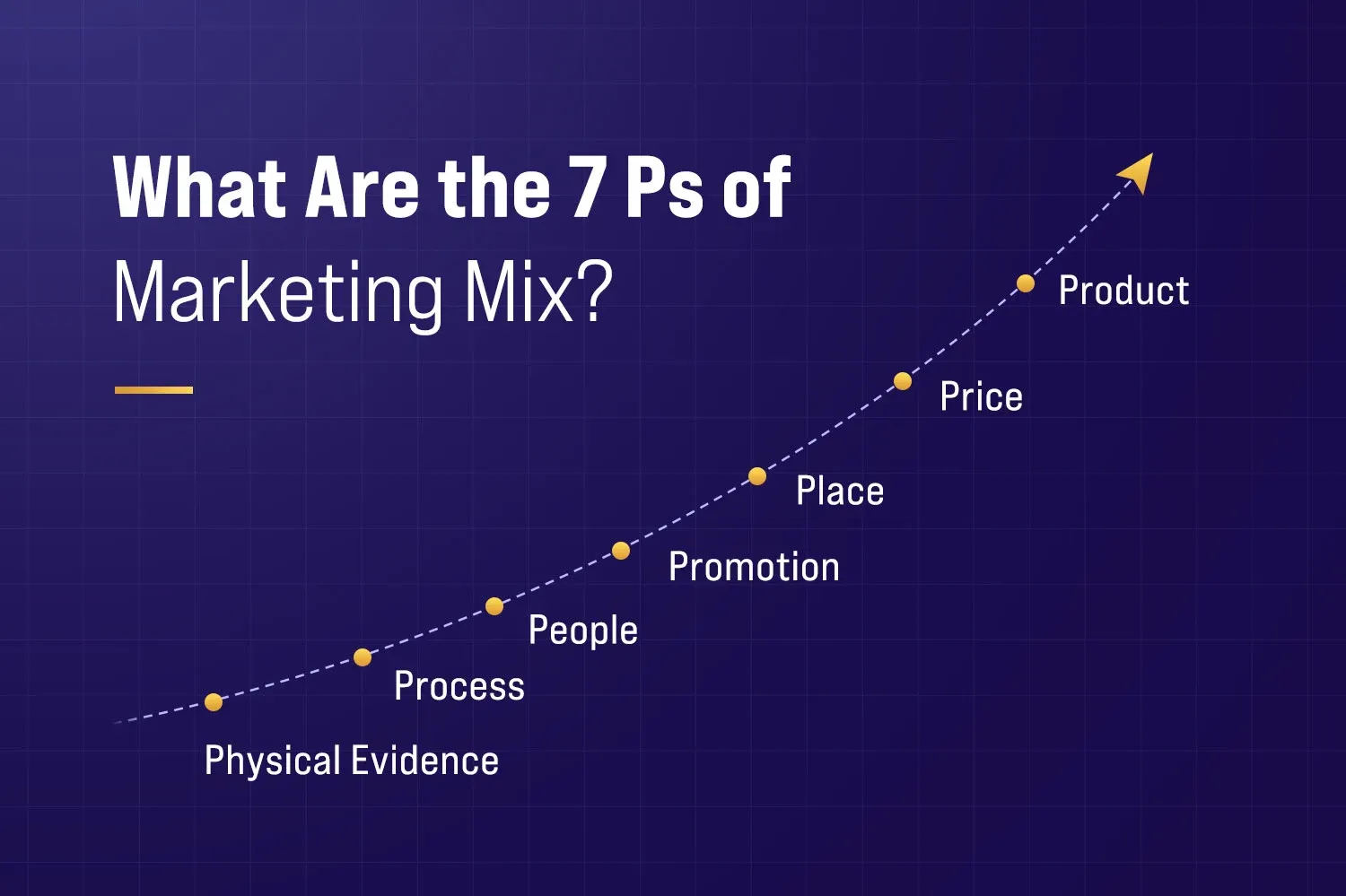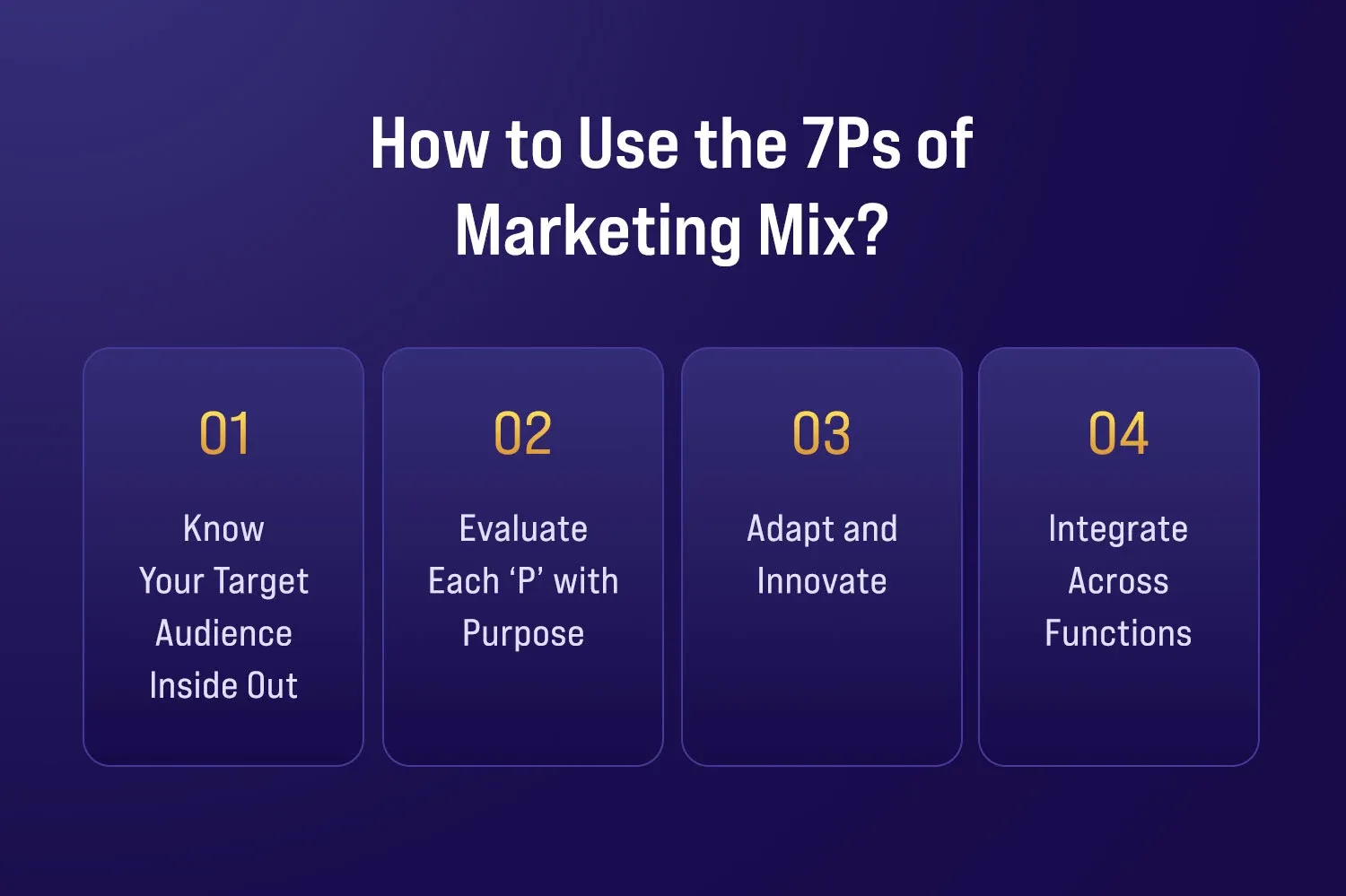What are the 7 Ps of Marketing?

At its essence, marketing revolves around providing customer value through calculated planning, uniform messaging, and synchronized business operations. Among the most lasting and influential frameworks to navigate this journey is the 7 Ps of Marketing, commonly known as the Marketing Mix.
Originally conceptualized as the 4 Ps—Product, Price, Place, and Promotion—by E. Jerome McCarthy, the model was later expanded by Booms and Bitner to include People, Process, and Physical Evidence, particularly to suit the needs of service-oriented businesses. Today, this comprehensive model is widely taught in business schools and used in industry to plan and execute effective marketing strategies. Let’s understand the 7 Ps of the marketing mix in detail.
What Are the 7 Ps of Marketing Mix?
The 7 Ps of Marketing mix offer a methodical approach to ensure every marketing campaign aligns with consumer requirements and corporate objectives. Let's examine each component:

Product
Product, the first P, encompasses what an organization provides to satisfy the desires and requirements of its intended audience. Products can be tangible goods (like electronics or clothing) or intangible services (like insurance or online education).
Marketing strategy effectiveness begins with thorough comprehension of product attributes, aesthetic, craftsmanship, identity, and the advantages it delivers to consumers. Effective product management strategies involve aligning the product’s value proposition with consumer expectations and market gaps.
Price
The second element, price, reflects the amount a customer is willing to pay in exchange for a product or service. Pricing strategies should consider costs, customer perceived value, competitor pricing, and market demand.
Strategies such as market entry pricing, benefit-oriented pricing, and flexible pricing enable companies to adjust prices according to market dynamics. Selecting appropriate pricing impacts consumer demand, financial returns, market positioning, and enduring customer dedication.
Place
The third P, which is Place, denotes how and where products are circulated and offered to buyers. Successful distribution tactics guarantee that products reach appropriate customers at optimal times and venues.
Businesses must choose the appropriate distribution channels, such as retail stores, eCommerce platforms, direct sales, or third-party sellers. Other considerations include logistics, inventory management, and market coverage.
Promotion
The fourth P, promotion, covers all the communication efforts used to raise awareness and persuade customers to purchase the product. Promotion encompasses various activities including advertising, media relations, internet marketing, direct sales, and promotional incentives.
The objective is to effectively convey product benefits, establish brand recognition, and enhance revenue. With digital channel proliferation, narrative marketing and virtual networks have become central to promotional approaches.
People
People, the fifth P, recognize that the human element plays a critical role in marketing success. This incorporates staff members, support representatives, and all individuals engaged in customer value delivery.
Interaction standards, worker knowledge, and attentiveness significantly influence customer contentment and brand perception. Businesses that invest in employee training, customer service, and stakeholder engagement gain a competitive advantage.
Process
The sixth P, Process, relates to the procedures and systems that deliver a product or service to customers. Efficient and well-defined processes improve customer satisfaction by ensuring consistency, speed, and quality in service delivery.
This includes everything from order processing and billing systems to customer support protocols and feedback loops. Companies must continuously evaluate and refine their processes to stay competitive and agile.
Physical Evidence
The concluding element, physical evidence, pertains to concrete indicators that assist customers in assessing a service or brand, particularly when offerings lack tangibility.
This can include branding, packaging, website design, store ambiance, brochures, employee uniforms, and any other physical manifestation of the brand. These cues help establish trust and shape customer expectations. Especially in the digital world, maintaining a strong online presence is essential.
What is an Example of a Marketing Mix?
To fully grasp how the 7 Ps come together in practice, let’s look at a well-known global brand that has mastered its marketing strategy: McDonald’s. This example highlights how a business can align each element of the marketing mix to create a cohesive and customer-focused experience.
Product
McDonald’s offers a standardized core menu with signature items like the Big Mac and McChicken, while also adapting its offerings to local tastes. For example, in India, consumers can purchase the McAloo Tikki Burger—a meat-free option customized for cultural preferences. This product adaptability enhances customer satisfaction and global reach.
Price
McDonald's implements a benefit-focused pricing methodology that emphasizes affordability while maintaining quality standards. Its menu includes budget meals, combo offers, and price segmentation across markets to suit local economic conditions. This renders the company accessible to diverse demographic segments.
Place
With over 40,000 locations worldwide, McDonald’s ensures customer convenience through a robust distribution strategy that includes dine-in restaurants, drive-thrus, home delivery, and digital ordering via mobile apps. Strategic store placements in malls, highways, and urban centers maximize visibility and accessibility.
Promotion
McDonald’s is known for its integrated marketing communications. The organization produces memorable television advertisements, outdoor displays, web promotions, social influencer collaborations, and social platform campaigns. It also uses seasonal promotions (e.g., the McRib comeback) and Happy Meal toys to engage different customer segments and maintain excitement.
People
Customer service is a cornerstone of McDonald’s success. This is why staff and other personnels undergo training to deliver prompt, courteous, and uniform customer assistance. In many markets, local employees bring cultural familiarity, further improving customer comfort and engagement.
Process
Efficiency is a key differentiator. McDonald’s has streamlined its order-taking, food preparation, and delivery processes. Whether you’re in New York or Tokyo, you can expect a similar service experience, driven by automation, standardized workflows, and technology integration (like self-service kiosks).
Physical Evidence
Despite being a fast-food chain, McDonald’s pays close attention to physical touchpoints. Branded packaging, clean uniforms, recognizable color schemes (red and yellow), digital menu boards, and restaurant layouts all reinforce the brand identity. Even the smell of food and presentation of meals add to the physical experience of the brand.
How to use the 7Ps of Marketing Mix?
Using the 7 Ps effectively requires a strategic, research-backed, and customer-focused approach. Here's how students and marketers can apply this powerful framework in real-world scenarios:

Know Your Target Audience Inside Out
Start by developing detailed buyer personas based on demographics, behaviors, needs, and pain points. Comprehensive audience insight forms the groundwork for making informed decisions across all 7 Ps.
Evaluate Each ‘P’ with Purpose
Approach each of the 7 elements of the marketing mix with critical thinking. Ask questions like:
- What need does our product fulfill?
- Are we pricing based on value, cost, or competition?
- Where is our target audience most likely to buy—online or offline?
- Which communication channels prove most efficient for connecting with your audience?
- Are the people involved trained and aligned with the brand?
- Is our process efficient and customer-friendly?
- Do we provide physical evidence that reassures customers and strengthens our brand?
Adapt and Innovate
The marketing mix should evolve with the market. Regularly review and refine your 7 Ps based on customer feedback, competitive shifts, new technologies, and changing business goals. Innovation is key to staying relevant.
Integrate Across Functions
A strong marketing mix doesn’t exist in isolation. It collaborates across departments of sales, operations, finance, and HR—to ensure every function supports and reinforces your strategy. Organizational coherence produces a more uniform and impactful customer journey.
Summing Up
The 7 Ps of Marketing provide a timeless and practical framework for crafting customer-centric strategies in both product- and service-based industries. From product design and pricing to customer service and delivery processes, each element plays a crucial role in shaping brand experience. Understanding and applying the 7 Ps is a strategic mindset that enables better decision-making, adaptability, and value creation in a dynamic marketplace.
As markets evolve and customer expectations shift, the true power of the 7 Ps lies in their flexibility and relevance. By continuously analyzing, integrating, and optimizing each component of the mix, businesses can not only meet customer needs more effectively but also build a sustainable competitive advantage.





